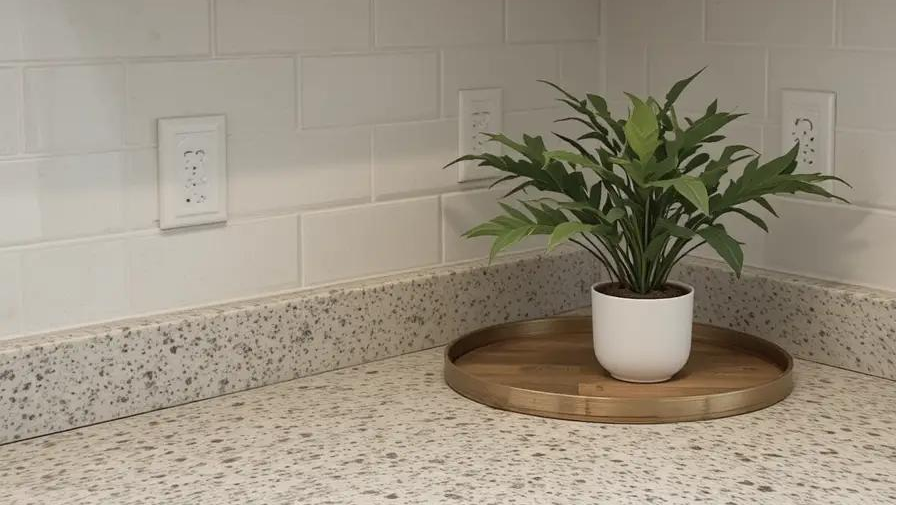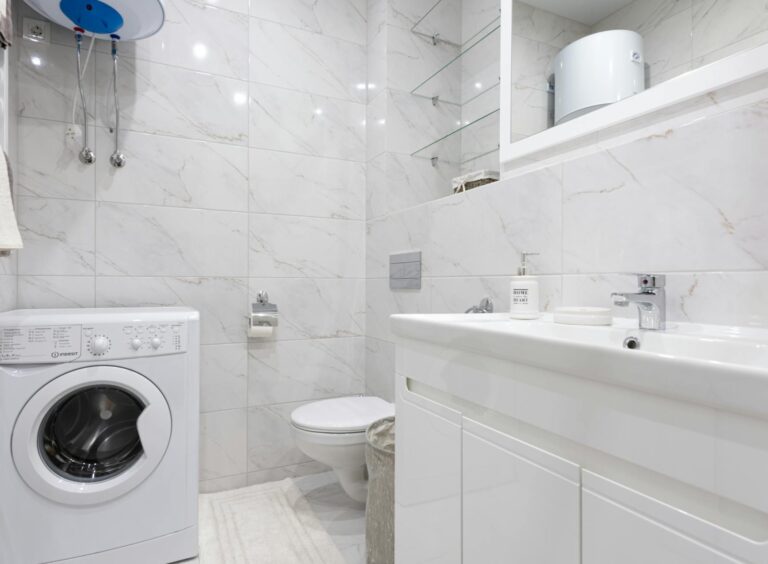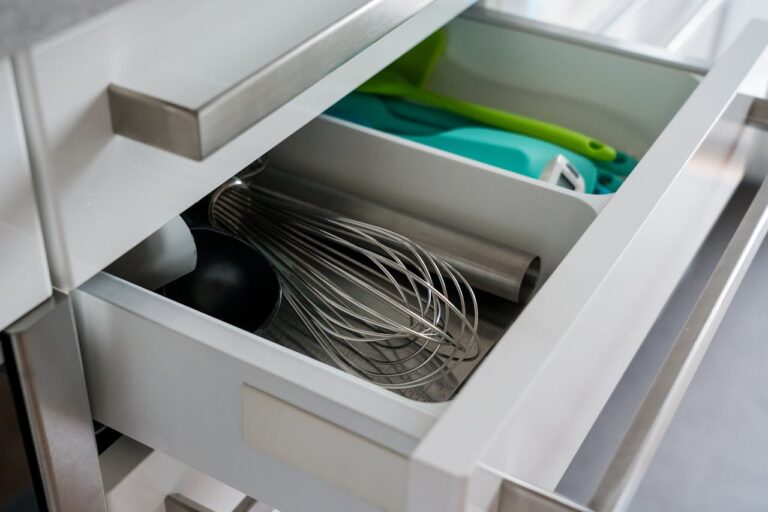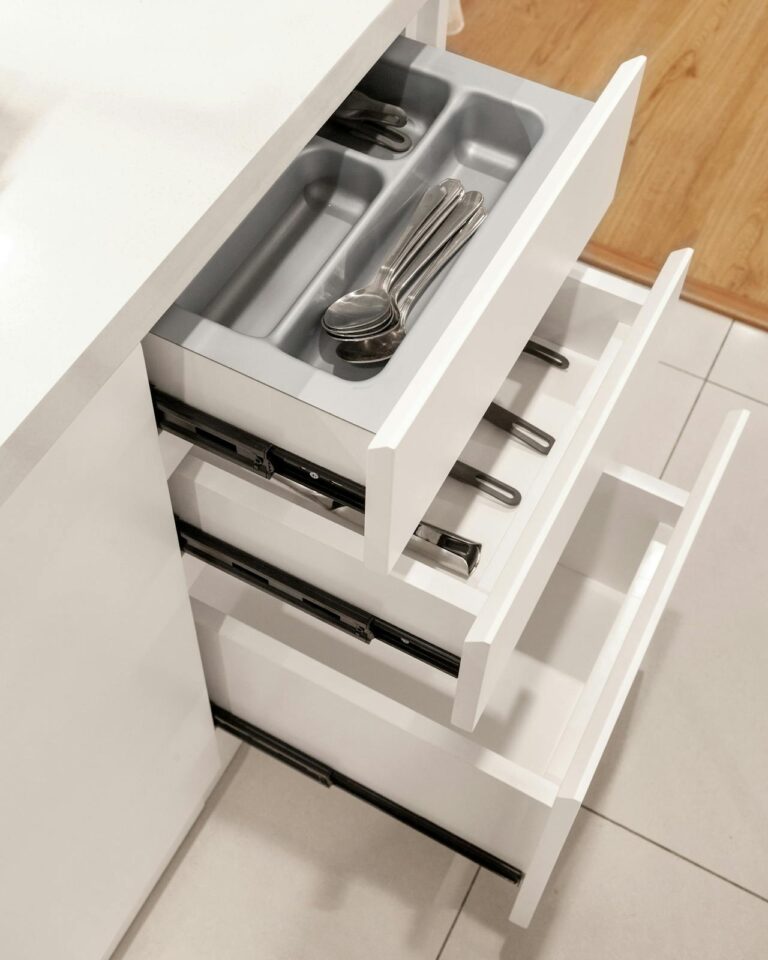A transitional kitchen strikes the perfect balance between traditional warmth and contemporary clean lines. This versatile design approach helps create spaces that feel both current and comfortable—perfect for homeowners who appreciate classic elements but want their kitchen to feel fresh and updated. Transitional kitchens have become increasingly popular because they allow you to combine the best of both worlds without committing fully to either style.
If you’re planning a kitchen renovation or simply looking for ways to refresh your cooking space, these 15 transitional kitchen ideas will help you achieve that ideal blend of timeless and modern. Let’s explore how you can transform your kitchen into a functional, beautiful space that marries traditional beauty with contemporary flair.
1. Two-Tone Cabinetry
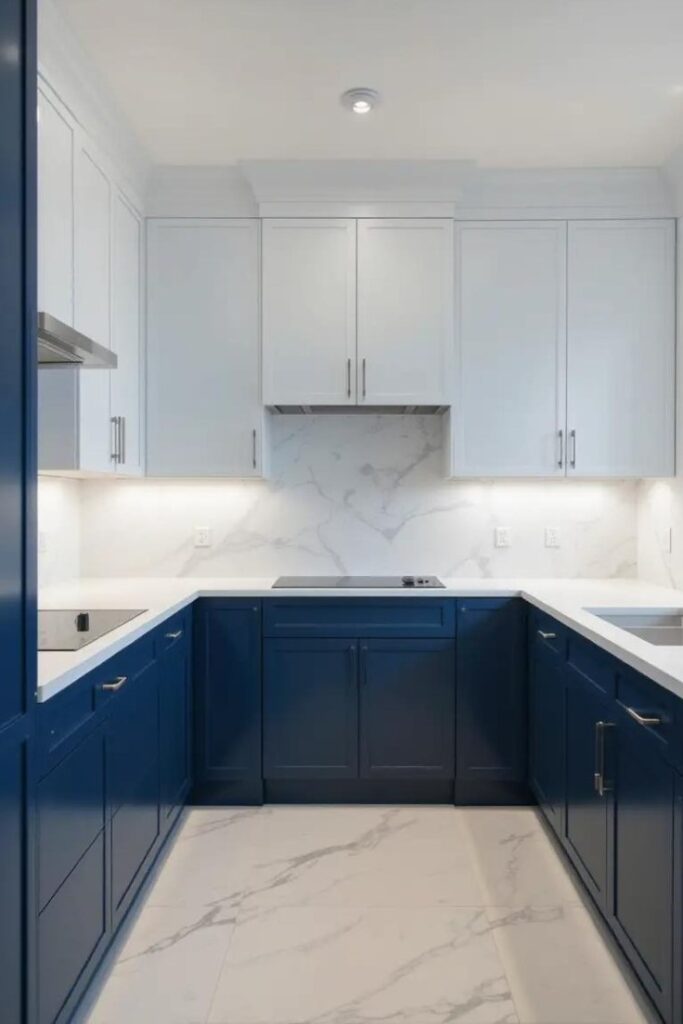
One of the most distinctive features of a transitional kitchen is the strategic use of two-tone cabinetry. This approach typically pairs white or cream upper cabinets with darker lower cabinets in navy, gray, or wood tones. The contrast creates visual interest while maintaining a balanced look.
For a successful two-tone transitional kitchen, consider keeping the upper cabinets light to maintain brightness and make the space feel larger. Then, ground the design with darker base cabinets that add depth and hide everyday wear and tear more effectively.
2. Shaker-Style Cabinet Doors
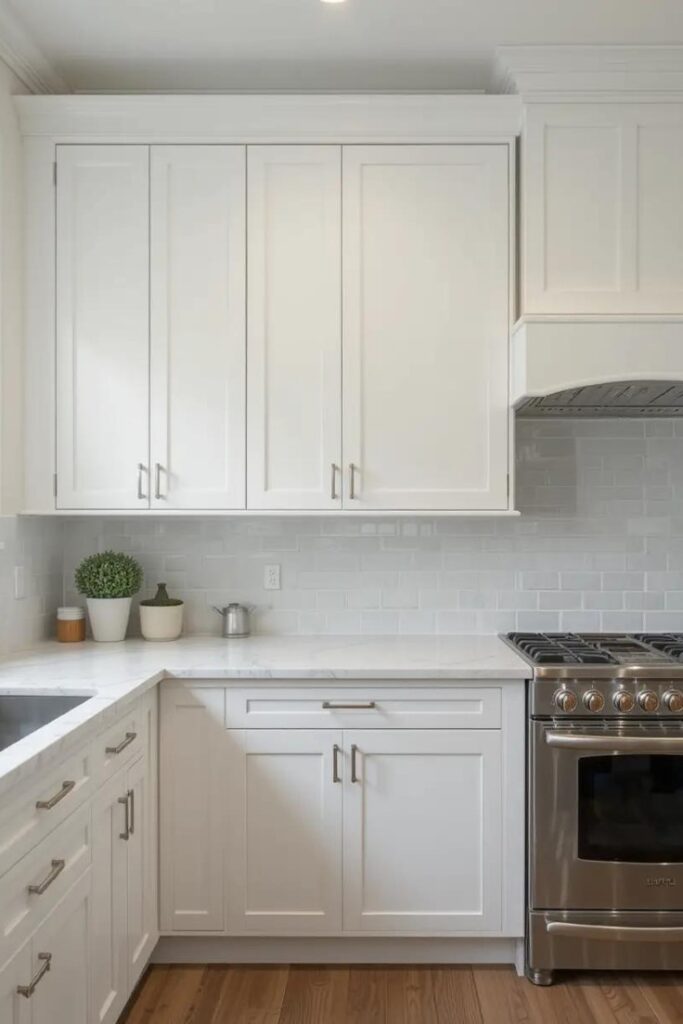
Shaker cabinets serve as the perfect foundation for a transitional kitchen design. Their simple, clean lines nod to traditional craftsmanship while their unfussy appearance works beautifully with modern elements. Shaker cabinets are essentially the transitional kitchen’s signature element—they bridge the gap between ornate traditional cabinetry and ultra-sleek modern designs.
For a contemporary twist, choose Shaker cabinets with minimal detailing and pair them with modern hardware in brushed nickel, matte black, or brass finishes.
For more kitchen ideas, see 15 Gray Kitchen Ideas That Feel Sleek and Sophisticated.
3. Quartz Countertops
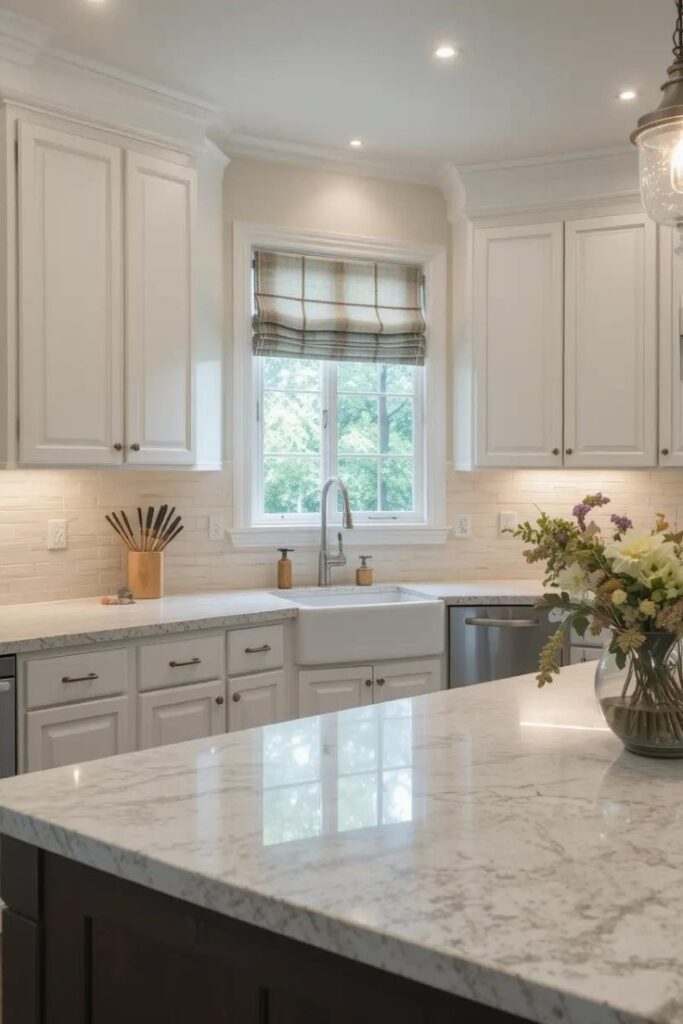
While natural stone like marble has classic appeal, quartz countertops deliver the perfect transitional look with added practicality. Quartz offers the elegant appearance of natural stone but with superior durability and easier maintenance—making it ideal for busy transitional kitchens.
Look for quartz in subtle patterns that mimic marble or limestone for a refined look, or opt for solid colors in whites, grays, or taupes that complement both traditional and modern elements in your space.
4. Subway Tile with a Twist
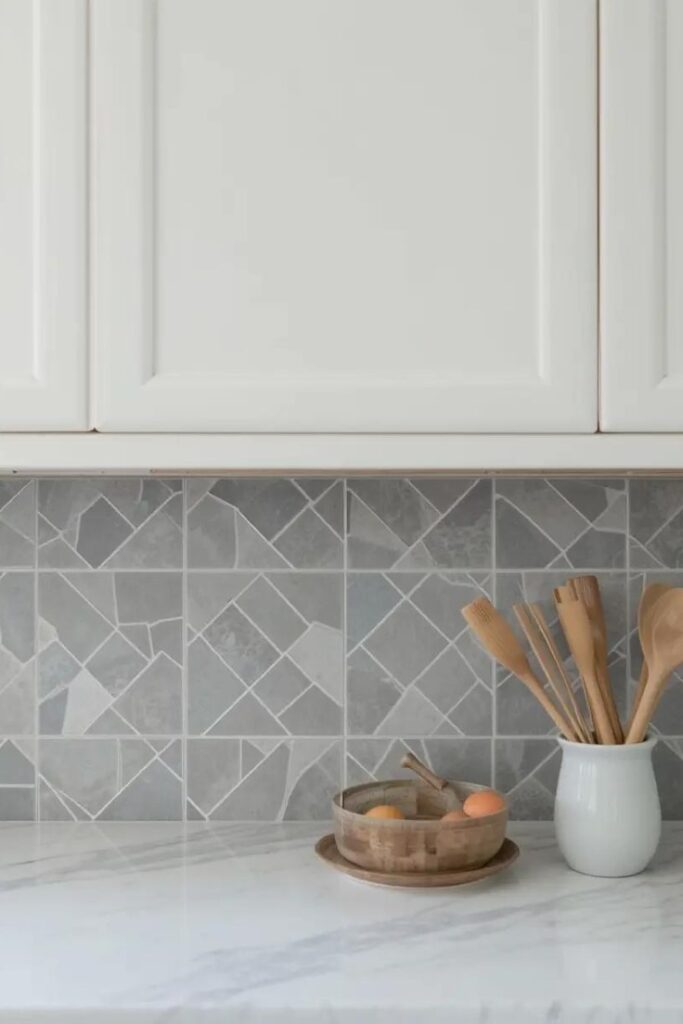
Classic subway tile remains a transitional kitchen staple, but today’s designs often incorporate subtle variations. Consider:
- Elongated rectangular tiles
- Handmade tiles with slight irregularities
- Subtle color variations beyond basic white
- Interesting installation patterns like herringbone or vertical stacking
These updated approaches to subway tile honor traditional elements while introducing contemporary interest—perfectly capturing the transitional kitchen aesthetic.
5. Mixed Metals and Finishes
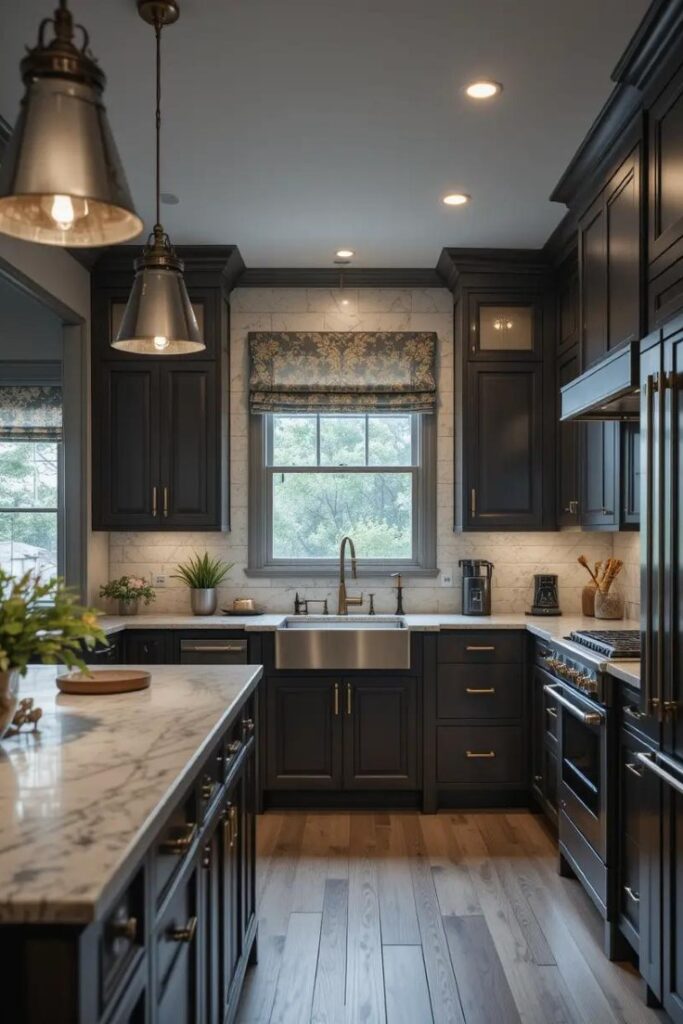
Gone are the days when all hardware needed to match. Transitional kitchens embrace thoughtfully mixed metals that add depth and character. The key to successful metal mixing in a transitional kitchen is limiting your selection to 2-3 complementary finishes and distributing them evenly throughout the space.
Popular transitional kitchen metal combinations include:
- Brushed nickel faucets with brass cabinet pulls
- Matte black lighting with stainless steel appliances
- Aged brass hardware with polished chrome accents
6. Statement Lighting
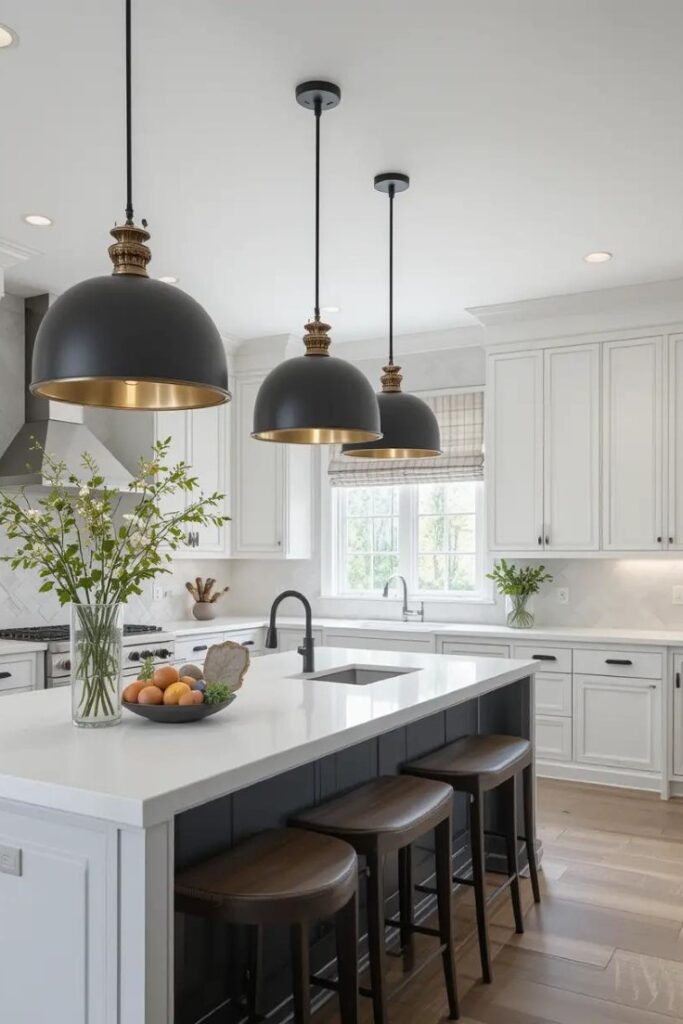
Lighting in a transitional kitchen serves both functional and decorative purposes. Well-chosen lighting fixtures can act as the perfect bridge between traditional and contemporary elements, anchoring your transitional kitchen design.
Consider pendant lights over islands that feature classic shapes rendered in modern materials, or traditional lantern styles updated with clean lines and current finishes. The right lighting creates focal points while illuminating work areas and setting the overall mood.
7. Open Shelving Combined with Cabinetry
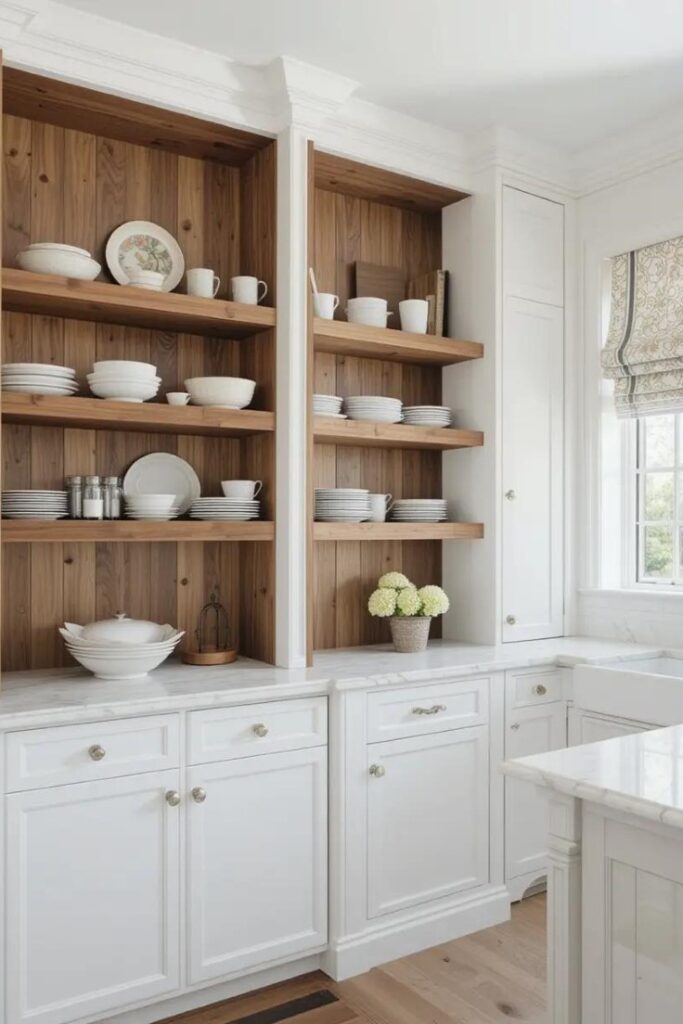
Transitional kitchens often incorporate the best of both storage worlds: traditional closed cabinetry paired with modern open shelving. This combination provides practical storage while creating display opportunities and visual breathing room.
For a cohesive transitional kitchen look, limit open shelving to specific areas rather than replacing all upper cabinets. This approach maintains sufficient closed storage while adding contemporary openness and styling opportunities.
8. Furniture-Style Islands

A hallmark of transitional kitchen design is the furniture-style island that looks more like a beautiful piece of furniture than built-in cabinetry. These islands often feature:
- Decorative legs or feet
- Contrasting colors or finishes
- Specialized storage solutions
- Thicker countertop edges
The furniture-style island serves as a transitional kitchen centerpiece that marries the craftsmanship of traditional design with the functionality of modern workspaces.
9. Neutral Color Palette with Texture
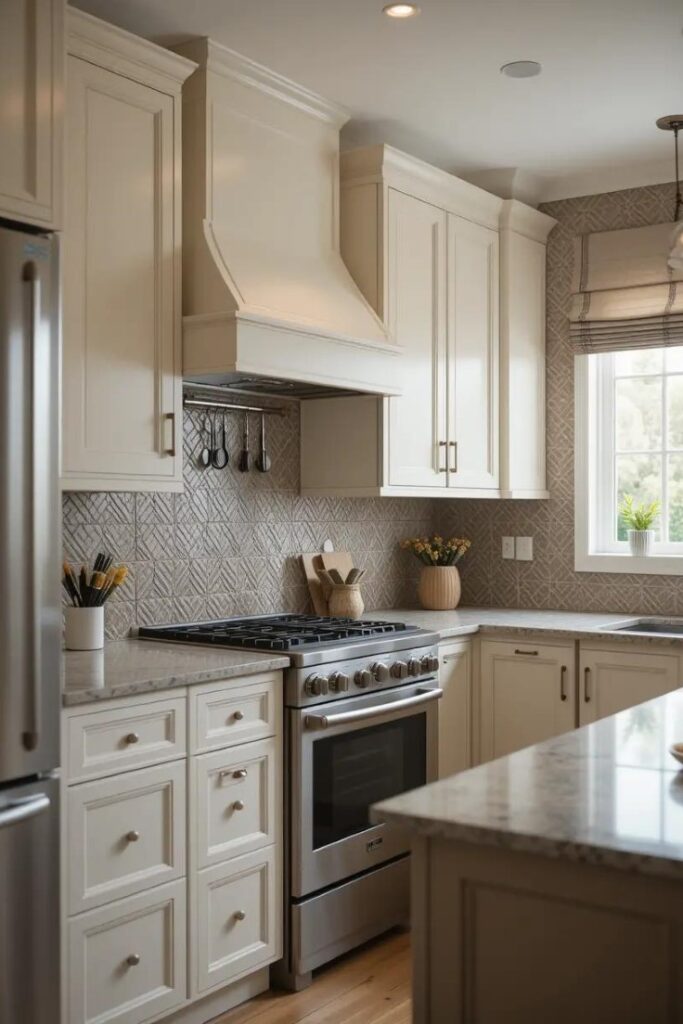
Transitional kitchens typically embrace a neutral color scheme that feels both timeless and current. Rather than relying on bold colors, these spaces create interest through texture and subtle variations in neutral tones.
The sophisticated restraint of a neutral palette allows architectural elements and mixed materials to shine in a transitional kitchen. Consider layers of whites, creams, grays, taupes, and warm woods to create a space that feels cohesive yet interesting.
If you’re looking for more inspiration, check out 23 Kitchen Decor Ideas to Transform Your Space for more ways to enhance your kitchen.
10. Modern Appliances with Traditional Surroundings
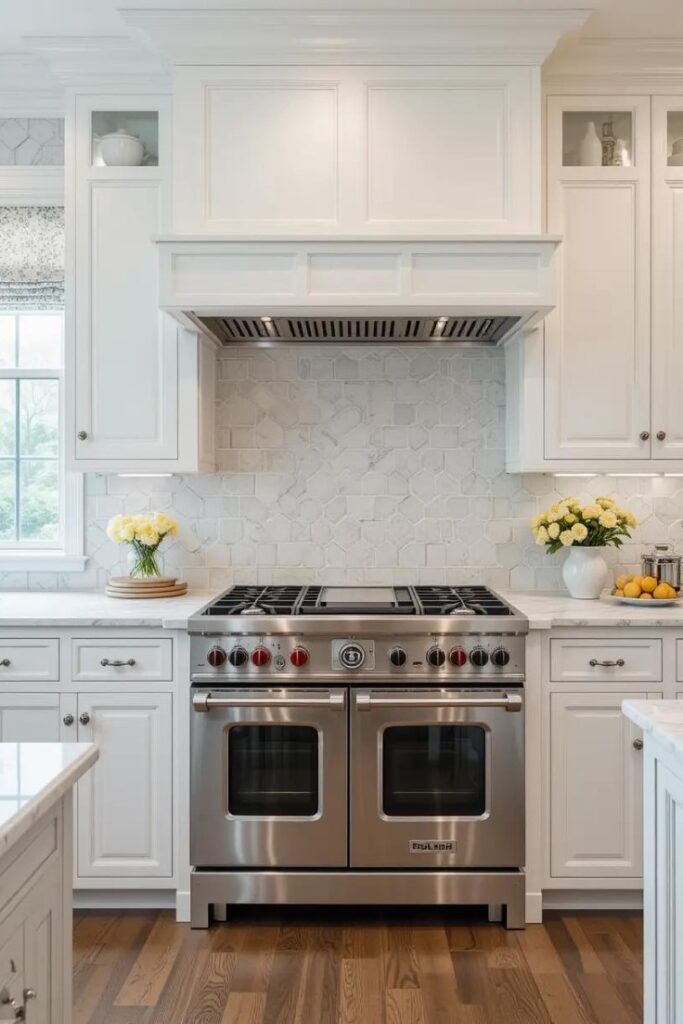
In a transitional kitchen, high-performance modern appliances pair beautifully with more traditional cabinetry and architectural details. This juxtaposition of contemporary function with classic form perfectly captures the transitional kitchen philosophy.
Consider integrating professional-grade stainless steel appliances within traditional cabinet surrounds, or partially concealing modern refrigerators with panels that match your cabinetry for a more blended look.
11. Natural Wood Elements
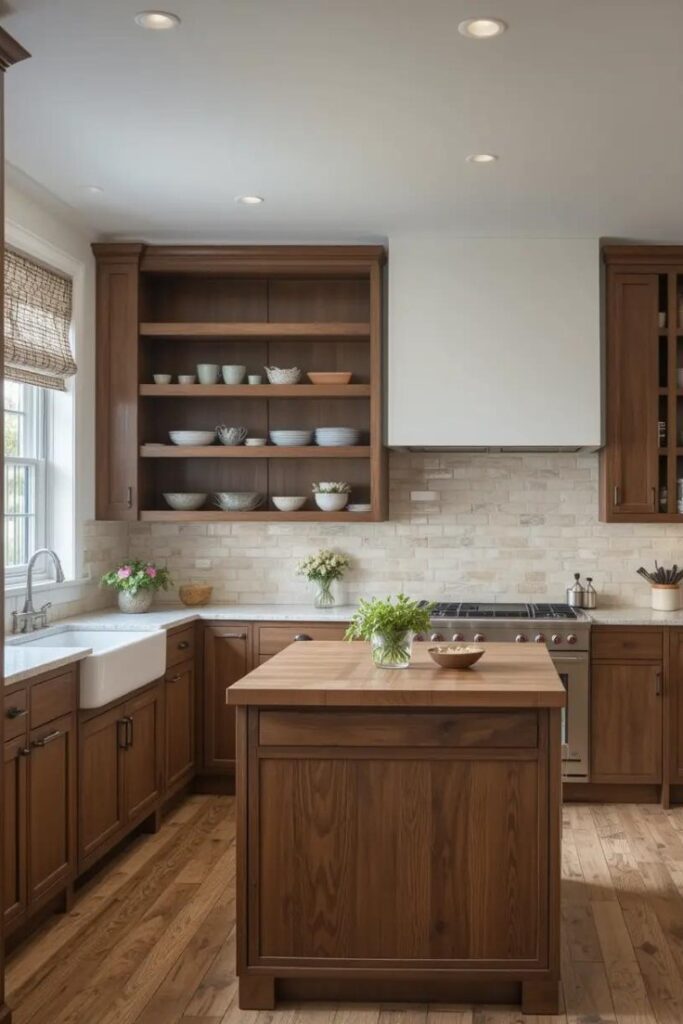
Incorporating natural wood brings warmth and organic texture to transitional kitchens that might otherwise feel too sleek or cold. Wood elements add necessary balance in transitional design, softening modern materials like glass and metal while complementing traditional features.
Consider introducing wood through:
- Hardwood flooring
- Butcher block countertop sections
- Exposed ceiling beams
- Bar stools or furniture
- Floating shelves
12. Glass-Front Cabinet Doors
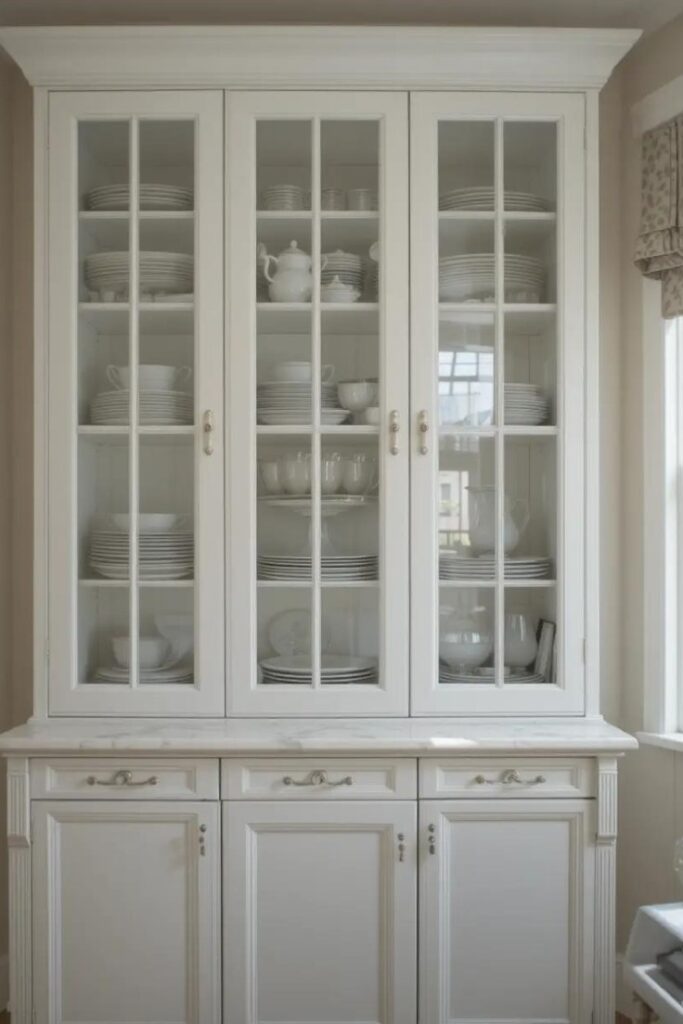
Strategically placed glass-front cabinets provide traditional beauty while maintaining a light, open feel that appeals to contemporary sensibilities. In transitional kitchen design, glass cabinets create display opportunities while breaking up solid cabinetry runs.
For the most versatile look, limit glass-front cabinets to upper sections where you can display attractive dishware or decorative items. Choose simple glass panels rather than leaded or decorative glass for a cleaner transitional aesthetic.
13. Undermount Sinks with Bridge Faucets
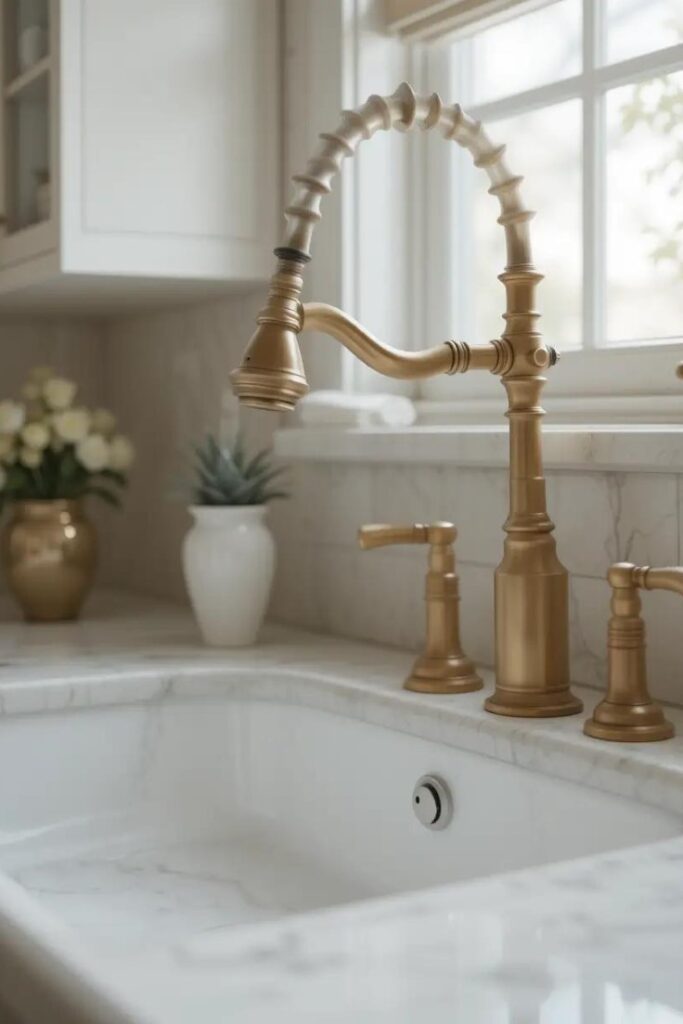
The sink area offers another opportunity to blend traditional and contemporary elements. Pairing a clean-lined undermount sink with a more traditional bridge faucet creates that perfect transitional kitchen tension between classic and current.
White farmhouse sinks also work beautifully in transitional kitchens, especially when combined with more modern faucets in contemporary finishes like matte black or brushed gold.
14. Architectural Ceiling Details

Drawing the eye upward with thoughtful ceiling treatments adds traditional character to transitional kitchens. Consider coffered ceilings, shallow vault details, or exposed beams that add architectural interest without feeling overly ornate.
These ceiling elements introduce traditional craftsmanship while maintaining the clean, uncluttered feel that transitional kitchens require. Painted in the same color as your walls or ceiling, these details add subtle dimension without visual heaviness.
For blue kitchen ideas, check out 20 Blue Kitchen Ideas for a Refreshing and Elegant Look.
15. Streamlined Window Treatments
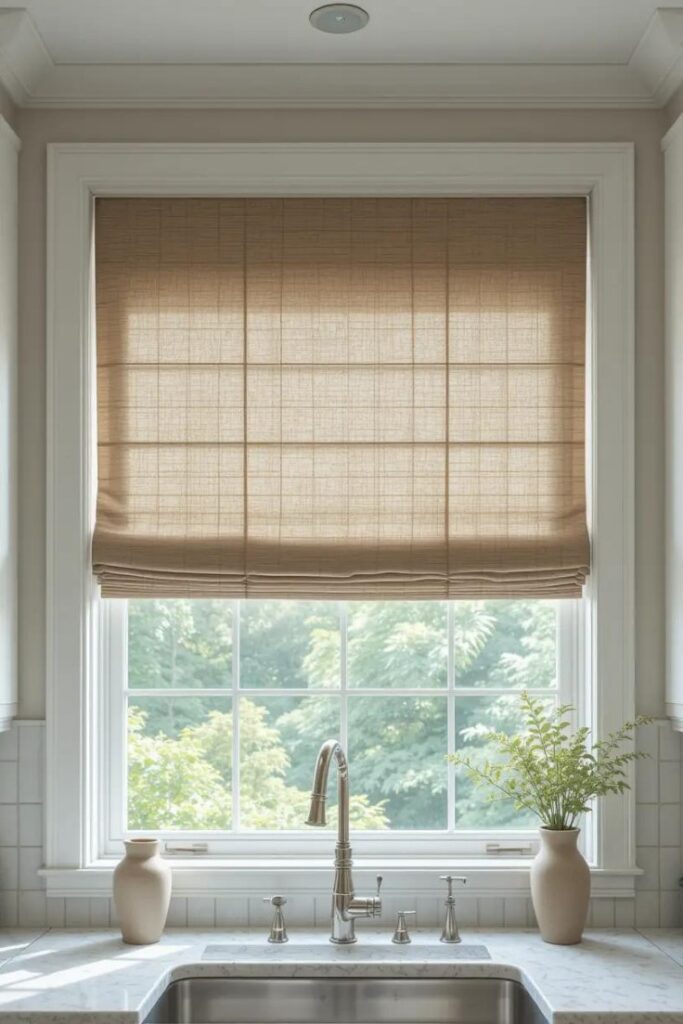
Window treatments in transitional kitchens should enhance natural light while adding just enough softness and texture. The best transitional kitchen window treatments maintain clean lines while introducing subtle pattern or texture.
Consider Roman shades in natural materials like linen or bamboo, or simple curtain panels with minimal detailing. Avoid fussy valances or heavy drapes that would feel too traditionally formal in a transitional kitchen.
Creating Your Optimal Transitional Kitchen
When designing your transitional kitchen, remember that balance is key. For every traditional element you include, consider a modern counterpoint. The most successful transitional kitchens feel cohesive rather than chaotic because they’re guided by a clear vision rather than trends.
Start with a neutral foundation, incorporate quality materials that stand the test of time, and focus on creating a functional layout that supports how you actually use your kitchen. By thoughtfully combining elements from different design eras, you’ll create a transitional kitchen with enduring appeal that won’t quickly feel dated.
Whether you’re undertaking a complete renovation or making smaller updates, these transitional kitchen ideas will help you create a space that feels both fresh and familiar—the perfect setting for cooking, gathering, and creating memories for years to come.
Frequently Asked Questions About Transitional Kitchens
What exactly makes a kitchen “transitional”?
A transitional kitchen combines traditional and contemporary design elements in a balanced way. This typically includes classic architectural details paired with clean lines, natural materials alongside modern finishes, and an overall neutral color palette enhanced by textural elements rather than bold colors or patterns. The hallmark of transitional design is its ability to feel current without being trendy and comfortable without being old-fashioned.
Are transitional kitchens more expensive than other styles?
Not necessarily. The cost of a transitional kitchen depends primarily on your material choices, layout changes, and appliance selections—just like any kitchen renovation. Because transitional design emphasizes quality over quantity and relies on neutral elements that don’t need frequent updating, it can actually be more cost-effective over time than trendier styles that may feel dated more quickly.
How do I ensure my transitional kitchen doesn’t look confused or mismatched?
The key to a cohesive transitional kitchen is intentional balance and restraint. Choose a neutral color palette as your foundation, limit your material palette to 3-4 key elements, and ensure there’s consistent visual weight throughout the space. Each element should feel purposeful rather than random. When mixing traditional and modern features, look for connecting elements—similar colors, complementary shapes, or related finishes—that help bridge different design eras.
Can I incorporate some colorful elements into my transitional kitchen?
Absolutely! While transitional kitchens typically feature neutral backgrounds, selective use of color can add personality and interest. Blue tones—from navy to soft blue-grays—work particularly well in transitional spaces, as do muted greens and warm terracottas.
How do I update my traditional kitchen to a more transitional style without a complete renovation?
Start with simpler updates like painting existing cabinetry in a fresh neutral color, swapping ornate hardware for more streamlined options, and updating lighting fixtures to styles that blend traditional shapes with modern finishes. Consider removing some upper cabinet doors to create open shelving sections, introducing mixed metals through new fixtures and hardware, and replacing patterned backsplash tile with simple subway or handmade ceramic tiles. These changes can significantly shift your kitchen’s style without requiring major structural changes.

